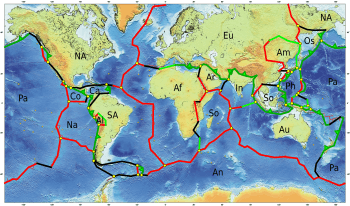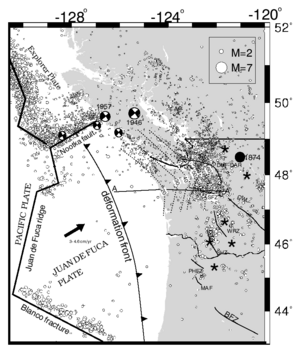Triple junction facts for kids

A triple junction is the point where the boundaries of three tectonic plates meet. At the triple junction each of the three boundaries will be one of 3 types – a ridge (R), trench (T) or transform fault (F) – and triple junctions can be described according to the types of plate margin that meet at them (e.g. Transform-Transform-Trench, Ridge-Ridge-Ridge, or abbreviated F-F-T, R-R-R).
Of the many possible types of triple junction only a few are stable through time ('stable' in this context means that the geometrical configuration of the triple junction will not change through geologic time). The meeting of 4 or more plates is also theoretically possible but junctions will only exist instantaneously.
Examples

- The junction of the Red Sea, the Gulf of Aden and the East African Rift centered in the Afar Triangle (the Afar Triple Junction) is the only Ridge-Ridge-Ridge (R-R-R) triple junction above sea level.
- The Rodrigues Triple Junction is a R-R-R triple junction in the southern Indian Ocean, where the African, the Indo-Australian and the Antarctic Plates meet.
- The Galapagos Triple Junction is an R-R-R triple junction where the Nazca, the Cocos, and the Pacific Plates meet. The East Pacific Rise extends north and south from this junction and the Galapagos Rise goes to the east. This example is made more complex by the Galapagos Microplate which is a small separate plate on the rise just to the southeast of the triple junction.
- Chiapas coast off Tapachula where Guatemala, North America and Pacific join and small earthquakes occur weekly. This is pushed eastward by the Cocos plate.
- On the west coast of North America is another unstable triple junction offshore of Cape Mendocino. To the south, the San Andreas Fault, a strike-slip fault and transform plate boundary, separates the Pacific Plate and the North American Plate. To the north lies the Cascadia subduction zone, where a section of the Juan de Fuca Plate called the Gorda Plate is being subducted under the North American Plate, forming a trench (T). Another transform fault, the Mendocino Fault (F), runs along the boundary between the Pacific Plate and the Gorda Plate. Where the three intersect is the seismically active, F-F-T Mendocino Triple Junction.
- The Amurian Plate, the Okhotsk Plate, and the Philippine Sea Plate meet in Japan near Mount Fuji. (see Mount Fuji's Geology)
- The Azores Triple Junction is a geologic triple junction where the boundaries of three tectonic plates intersect: the North American Plate, the Eurasian Plate and the African Plate, R-R-R.
- The Boso Triple Junction offshore Japan is a T-T-T triple junction between the Okhotsk Plate, Pacific Plate and Philippine Sea Plate.
- The North Sea is located at the extinct triple junction of three former continental plates of the Palaeozoic era: Avalonia, Laurentia and Baltica.
- The South Greenland Triple Junction was an R-R-R triple junction where the Eurasian, Greenland and North American plates diverged during the Paleogene.
See also
 In Spanish: Triple unión tectónica para niños
In Spanish: Triple unión tectónica para niños

